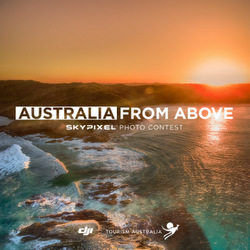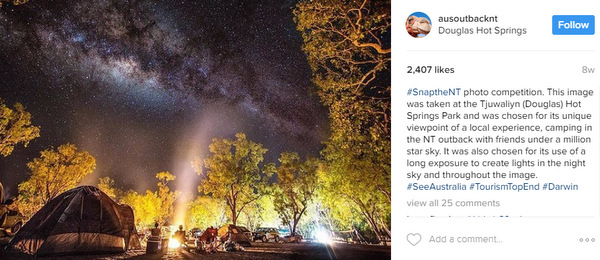Photographers are calling on Tourism Australia and DJI to amend its ‘right-grabbing’ Terms and Conditions for aerial photo contest Australia from Above.
 Anyone entering Australia’s ‘first aerial photo contest’, according to the T&Cs, grant Tourism Australia and DJI permission to do practically anything with the photos.
Anyone entering Australia’s ‘first aerial photo contest’, according to the T&Cs, grant Tourism Australia and DJI permission to do practically anything with the photos.
That includes publishing and printing, exploiting, adapting and destroying!
The contest – supported by Epson, SanDisk, and Adobe provides the contest organiser and its affiliates:
‘A non-exclusive, irrevocable, royalty-free, worldwide, perpetual, sub-licensable and transferable license to use and exploit the intellectual property rights’ of entrants’.
The organiser may ‘edit, publish, print, use, adapt, translate, exploit, modify, include in a compilation, copy, disseminate, dispose, load onto its server, broadcast and/or transit each entrants photo for advertising, promotional display, and/or publicity purposes’.
The grand prize is a DJI Inspire 2 Premium Combo Drone Package and a trip for two to Lord Howe and Kangaroo Island. As far as photo contests go, this is a top prize.
However the T&Cs state that winners are required to hand over all footage they capture while visiting the two island. Even the prize has a catch, hidden away in the fine print.
Commercial photographer William Long, who replaces his camera with a magnify glass to monitor photo contest T&Cs as ‘The PhotoWatchDog’, was alerted by multiple photographers to ‘Australia From Above’.
The purpose of PhotoWatchDog is to encourage a fair, honest and ethical approach to photo contests. Long campaigns for honesty and transparency, and fair rights within contest T&Cs.
He wasn’t impressed with Australia From Above, and found it particularly irritating – but a common occurrence – that the T&Cs were buried deep in the competition website.
DJI appears to be adopting a similar ‘content marketing’ approach to GoPro. The action cam company had immense success crowdsourcing footage from customers to promote its products, providing a cost-effective and authentic approach to marketing. For DJI, which like GoPro is a market leader in a new and niche technology, a similar approach could reap similar rewards.
Tourism Australia, William Long says, has form in sourcing images in this way and suspects it had a hand in drafting the T&Cs.
‘Tourism Australia has a bad track record. In fact, all the tourism authorities do. They support competitions because it’s a great way to get images they can later use. It goes into a data bank and is stored and used whenever,’ he told ProCounter. ‘If people want to give their work away – or give away something that they love doing – that’s fine. But I’ve had so many people come to me surprised that their photo has ended up on a billboard or somewhere similar. They expect the Terms & Conditions to be a fair contract, and then that happens.’
As Long says, photo contests are run routinely by all tourism authorities to source images.
Tourism NT, for instance, ran photo contest in January called ‘Snap the NT’. Entrants submitted photos through Instagram – a valuable visual platform for tourism promotion. Entry required the hashtag #snaptheNT, #NTAustralia and tagging the agency’s Instagram handle.
The winner received a $500 Camera House voucher. Although the real winner is Tourism NT, which ‘won’ an exclusive, perpetual, worldwide license to 250 images and to the entrants’ personal information. All moral rights and intellectual property rights are ‘waived’. It also received limited media coverage for the contest.
According to the T&Cs the photos can’t even be published elsewhere – Tourism NT has exclusive publishing rights!
While the T&Cs stand on shaky legal ground (Long suggests it’s potentially an unconscionable or unfair contract, but that’s yet to be tested legally), there’s also the lost opportunity cost – these could be paying gigs for professional photographers. The tourism authorities, which are well bankrolled by government, need the photos generated by these competitions.
The benefits are obvious. The contract is non-negotiable and seldom read; entrants’ photos, which vary widely in subject and style, can be archived for later use; and it’s cheaper and easier than hiring a photographer or licensing photos.
Especially bad T&Cs also allow the photos to be shared and licensed to third parties or affiliates, and entrants are held liable for how the photos are used.
Long paints a worst case scenario where a photo of an uncle and his niece are photographed at the beach and the picture is entered into a contest run by a tourism authority looking for that quintessential ‘beach snap’.
The photo lays dormant for 10 years in a database that’s shared with all government departments, as per the T&Cs.
‘All the marketing managers have changed, people have changed. And someone in the marketing department of the police, an affiliate department, needs a photo for an upcoming paedophile alert. So they use this old image from the database, and totally break apart the original context of the photos. The family sees the image, but can’t do anything – according to the contract the photographer is liable. It’s simply not fair.’
Long says in most cases contest organisers aren’t out to cheat photographers or bypass licensing photos, and Tourism Australia has provided positive responses previously.
Lawyers often draft T&Cs and ensure there’s no underlying legal issues. Many organisers are quick to rewrite the T&Cs realising that they’re effectively a rights-grab. Over the years, Long says he has had more positive than negative experiences seeking resolutions.
As the PhotoWatchDog, which has almost 5000 Facebook followers, Long says he has monitored up to 300 contests a year. These days, it’s closer to 150 – he suspects photographers are more savvy and now read the T&Cs.
Occasionally a contest warrants Long barking at or endorsing it. He rates contests as either ‘Top Dog’, ‘Good Dog’, ‘Bad Dog’, and ‘Apawling’.
Australia From Above qualifies as Apawling.
 The PhotoWatchDog
The PhotoWatchDog
Two decades ago Long became suspicious of a huge photo contest called Moments of Intimacy, Love and Kinship (MILK).
‘I think it attracted around 100,000 entrants worldwide, and it was about US$30 to enter (each image). The prize was US$100,000, but doing the sums – well, it doesn’t take much to realise a fairly healthy profit was made from it,’ he said.
Beyond earning money from entry fees, the photos were stored into a database by the company and were indiscriminately licensed – without the consent of the photographer, as per the T&Cs – to be used on postcards, in calendars, matchbook covers, and so on.
Long noticed this was a growing trend. Photo contests run by businesses, not-for-profits and government departments were popping up everywhere. So he started investigating them – there wasn’t anyone else in Australia, and few in the world, doing it.
‘I’d ask them “what’s your intent here? Is it to gather images or just to run a competition?”. I found many organisers were very receptive – but some didn’t like being caught out and would push back or evade my questions,’ he said.
He’s often asked to send everything to the company in writing. This side-steps direct communication, avoids an awkward conversation, and creates a long ‘bureaucratic mess’.
PhotoWatchDog is endorsed by the Australian Institute of Professional Photography (AIPP). This helps him to be taken seriously, but he maintains an arms-length, unofficial relationship with the association, enabling him to be more forthright.
Sometimes it’s more effective to simply tell an organiser what their contest smells like, he said.



William Long is doing a great job. Bravo !
Wow. William Long should get on the side of the regularly-exploited freelance video camera operators who try and shoot news for a living and only getting paid a once-only fee in the vicinity of $500 – $1000 per network and then watching their great pictures get played anywhere and everywhere, right around the world, all over the ‘net, for ever and a day, whilst they get paid no extra money for that broadcasting.
A one-off paltry fee is all they are worth, apparently. Weird – as that vision is worth so much more to the networks!